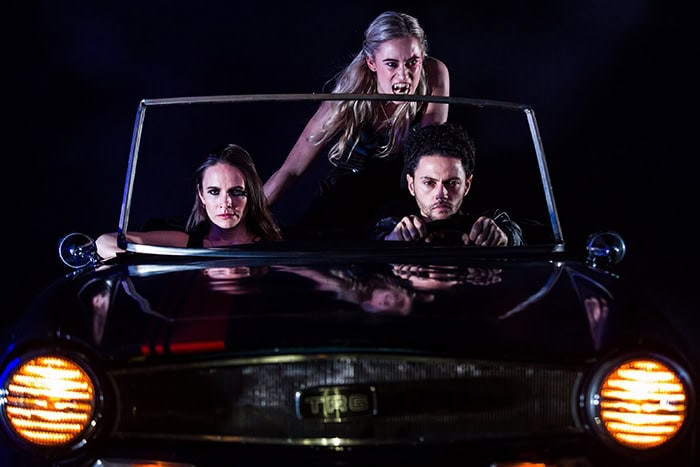Mark Bruce Company in Return to Heaven at Wilton’s Music Hall
Posted: March 10th, 2020 | Author: Nicholas Minns | Filed under: Performance | Tags: Christopher Thomas, Dane Hurst, Dean Sudron, Dorothee Brodrück, Eleanor Duval, Guy Hoare, Jordi Calpe Serrats, Jyn San Tsang, Mark Bruce, Phil Eddolls, Sharol Mackenzie | Comments Off on Mark Bruce Company in Return to Heaven at Wilton’s Music HallMark Bruce Company, Return to Heaven, Wilton’s Music Hall, March 3

Mark Bruce’s latest work, Return to Heaven, presented at Wilton’s Music Hall, bridges a vast arc of cultural references from the Egyptian pyramids to space exploration within a framework of a macabre sci-fi expedition. Journeys into darkness have been the subject of previous works by Bruce like Macbeth, The Odyssey and Dracula, but in Return to Heaven he seems to be working towards a resolution, a transmutation of dance theatre into a psychology of personal development, where losing yourself in the forest and fighting your way out against dark forces is a way to slay your own demons. All the program note reveals is a story ‘of an obscure expedition into the darkness of a jungle led by two explorers seemingly pursuing only a feeling that something awaits them, something they need to uncover.’ It might be called an existential fable with ghostly visions, ruthless mercenaries and vampire clinicians that uses its theatrical effects to illustrate the hazardous road to inner resolution. The fable is further construed through the optic of a delirious mind that cuts up and reassembles its narrative elements through the cinematic techniques of flashback, fast forward and recall as a non-linear phantasmagoria of associations. The advantage of such a path is to turn a time-traveling fable into a dense, multi-layered myth; the danger is that the signification of the myth may be lost in the complex shuffling of layers.
The visual aspect of Return to Heaven relies heavily on the collaboration between Phil Eddolls’ stage design, Guy Hoare’s lighting, Dorothee Brodrück’s costumes and Jyn San Tsang’s makeup, while Dean Sudron as stage manager has the unenviable task of coordinating all the complexities of the production in real time. As we enter the auditorium of Wilton’s Music Hall — itself a theatre whose atmosphere is redolent with mystery — the stage is engulfed in haze and tropical bird song. Within a sultry forest clearing against a backdrop of hanging creepers is the vague outline of a tent and a lectern in front of it that suggest the encampment of an archaeological expedition. Through the light we see Dane Hurst at the lectern writing in his journal, with a rifle at hand; Eleanor Duval as his expedition partner is lying on the ground suffering from a fever whose effects will manifest later. From this still point we enter into a fluid succession of images and visual explanations that Hoare’s lighting alternately reveals and hides, transforming time into a thick haze that holds within it the references that drive the fractured narrative.
In trying not to tell a linear story, Bruce subverts his aim by using a number of narrative devices and theatrical effects; each scene is emphasised like a chapter in a book even if the order of the chapters is jumbled, and Eddolls’ props — a tent, a Triumph TR6, a sarcophagus and a crashed spaceship — identify the specific details of the story even if we cannot immediately grasp their significance. At the same time, the artifice of theatrical effects — a rocket ship crash, a bloody severed head, a man-eating insect, a beached shark, and gory entrails — transports our belief into comic strip territory. There’s a fine line between chilling horror and lurid sensation that Return to Heaven negotiates only with difficulty.
Bruce enjoys an eclectic playlist, and he doesn’t disappoint; there are some 22 tracks in Return to Heaven collated from Krzysztof Penderecki, Akira Nishimura, Arvo Pärt, Irving Burgie, Mark Lanegan Band, PJ Harvey, Nick Cave and the Bad Seeds, Harry Belafonte, and Bruce himself. He uses the tracks either as source music for choreography or incidental music for creating moods and emotions, but the diversity and frequency of different tracks nevertheless constitutes the aural equivalent of an additional narrative device.
With such a strong focus on theatrical and aural effect, the dancing appears almost incidental. Carina Howard’s first solo, which is repeated later in the work, is full of upright, upbeat neoclassical steps that appear at odds with the prevailing mood, while Hurst’s range of virtuosic classical steps performed with characteristic intensity is so out of context in the battle scene that it is close to parody. Duval plays her ailments and obstacles to the edge of sanity and back, while Jordi Calpe Serrats, Christopher Thomas and Sharol Mackenzie all remain more attuned to the work’s expressive parameters.
In a production that professes to ‘transcend narrative’, Return to Heaven is too heavily weighted by its narrative devices. Transcendence is an experience, and it’s the experience that is missing.